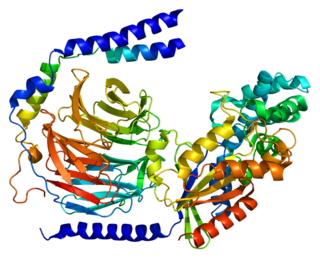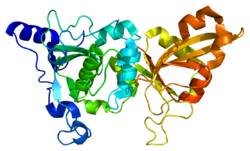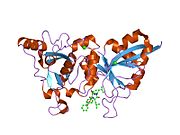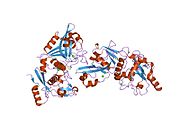
A calpain is a protein belonging to the family of calcium-dependent, non-lysosomal cysteine proteases expressed ubiquitously in mammals and many other organisms. Calpains constitute the C2 family of protease clan CA in the MEROPS database. The calpain proteolytic system includes the calpain proteases, the small regulatory subunit CAPNS1, also known as CAPN4, and the endogenous calpain-specific inhibitor, calpastatin.

Calpain-10 is a protein that in humans is encoded by the CAPN10 gene.

Calpain-2 catalytic subunit is a protein that in humans is encoded by the CAPN2 gene.
Calpain-3 is a protein that in humans is encoded by the CAPN3 gene.

Cyclic AMP-dependent transcription factor ATF-1 is a protein that in humans is encoded by the ATF1 gene.

AP-2 complex subunit alpha-1 is a protein that in humans is encoded by the AP2A1 gene.

Calcium/calmodulin-dependent protein kinase type IV is an enzyme that in humans is encoded by the CAMK4 gene.

Presenilin-2 is a protein that is encoded by the PSEN2 gene.

Cyclin-dependent kinase 5 activator 1 is an enzyme that in humans is encoded by the CDK5R1 gene.

Calpastatin is a protein that in humans is encoded by the CAST gene.

Proteasome activator complex subunit 2 is a protein that in humans is encoded by the PSME2 gene.

Guanine nucleotide-binding protein G(I)/G(S)/G(O) subunit gamma-2 is a protein that in humans is encoded by the GNG2 gene.
Calpain small subunit 1 (CSS1) is a protein that in humans is encoded by the CAPNS1 gene.

Guanine nucleotide-binding protein G(I)/G(S)/G(O) subunit gamma-12 is a protein that in humans is encoded by the GNG12 gene.

GPI-anchor transamidase is an enzyme that in humans is encoded by the PIGK gene.

Mitochondrial-processing peptidase subunit alpha is an enzyme that in humans is encoded by the PMPCA gene. This gene PMPCA encoded a protein that is a member of the peptidase M16 family. This protein is located in the mitochondrial matrix and catalyzes the cleavage of the leader peptides of precursor proteins newly imported into the mitochondria, though it only functions as part of a heterodimeric complex.

Guanine nucleotide-binding protein G(I)/G(S)/G(O) subunit gamma-13 is a protein that in humans is encoded by the GNG13 gene.

Guanine nucleotide-binding protein G(I)/G(S)/G(O) subunit gamma-4 is a protein that in humans is encoded by the GNG4 gene.

Interferon-alpha/beta receptor alpha chain is a protein that in humans is encoded by the IFNAR1 gene.

Calpain-9 is a protein that in humans is encoded by the CAPN9 gene.





















